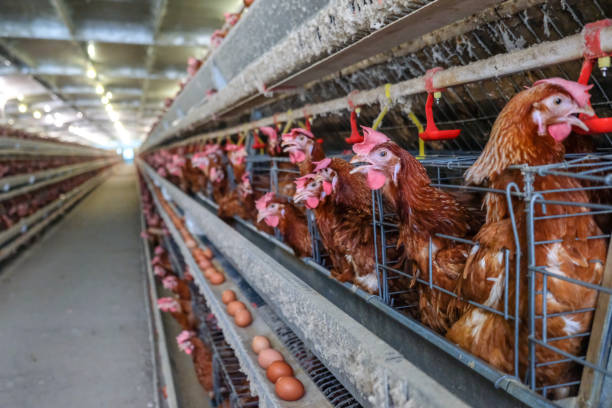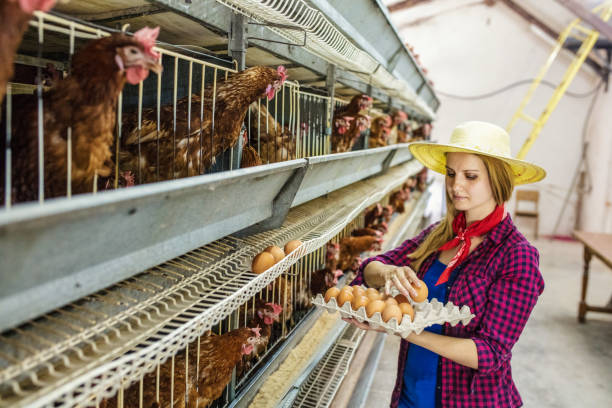
Affordable 20,000 Layer Chicken Cages for Sale in Africa
Affordable 20,000 Layer Chicken Cages for Sale in Africa
Africa’s poultry farming sector is experiencing a period of dynamic growth, driven by increasing demand for eggs and a rising awareness of the nutritional benefits of poultry products. For aspiring and established poultry farmers alike, the key to maximizing efficiency and profitability lies in adopting modern and cost-effective farming practices. One of the most crucial elements of a successful layer hen operation is the housing system, and in this regard, affordable 20,000-layer chicken cages offer a compelling solution for farms across the African continent.
This article delves into the specifics of 20,000-layer chicken cages, exploring their advantages, key design considerations, challenges to consider, and how to source the best and most affordable options for your poultry farm in Africa.
Why 20,000-Layer Chicken Cages? The Scale Advantage
Investing in a 20,000-layer chicken cage system represents a significant commitment to poultry farming, allowing farmers to achieve substantial economies of scale. Unlike smaller, less efficient systems, a system of this size unlocks a multitude of benefits.
Increased Egg Production: With 20,000 hens under your management, the potential for daily egg production is significantly higher. This increased output translates directly into higher revenue, improving bottom line margins.
Optimized Resource Utilization: Managing a larger flock allows for more efficient use of resources. Feed can be purchased in bulk at discounted prices, and labor costs are spread across a larger output, reducing the cost per egg.
Enhanced Automation Opportunities: A system of this scale makes it economically feasible to incorporate automated processes, such as automatic feeding systems, automatic manure removal systems, and automatic egg collection systems. Automation reduces labor requirements, improves hygiene, and minimizes the risk of human error.
Improved Management & Control: A well-designed cage system facilitates better monitoring of hen health and performance. Individual bird observation becomes easier, allowing farmers to identify and address health issues promptly, reducing mortality and maximizing egg production.
Space Efficiency: Cage systems are designed to maximize space utilization. By housing hens in multiple tiers, farmers can rear a larger number of birds within a limited area, making it ideal for farms where land is a constraint.
Types of Layer Chicken Cages Suitable for 20,000 Birds
When considering a 20,000-layer chicken cage system, there are primarily two types of cage systems to choose from:
A-Frame Cages: A-frame cages are a popular choice due to their simplicity and affordability. They are designed with cages arranged in an A-shape, typically with two to four tiers. A-frame cages are relatively easy to install and maintain. Manure removal is usually done manually, although semi-automatic options are available.
H-Frame Cages: H-frame cages are a more advanced and sophisticated system designed for greater efficiency and automation. The cages are arranged in an H-shape, often with multiple tiers. H-frame cages are well-suited for incorporating automated feeding, drinking, manure removal, and egg collection systems. While they require a higher initial investment, the long-term savings in labor and improved efficiency make them a worthwhile option for larger-scale operations.
Key Considerations When Choosing a Cage System
Selecting the right cage system for your 20,000-layer flock requires careful consideration of several key factors:
Cage Dimensions and Layout: Ensure that the cage dimensions comply with recommended stocking densities to promote bird welfare and optimize egg production. Adequate space per bird is crucial for minimizing stress and preventing behavioral problems. The layout of the cages should facilitate easy access for feeding, watering, and egg collection.
Material Quality and Durability: The cages should be constructed from high-quality, corrosion-resistant materials, such as galvanized steel, to withstand the harsh environmental conditions and ensure long-term durability. The gauge of the wire mesh should be sufficient to prevent sagging or breakage, which can injure the birds.
Ventilation and Lighting: Proper ventilation is essential for maintaining optimal air quality and preventing the buildup of harmful gases like ammonia. The cage design should promote adequate airflow. Lighting is also a critical factor in egg production. The cage system should allow for uniform light distribution throughout the hen house.
Feeding and Watering Systems: Choose a feeding system that ensures all birds have equal access to feed. Automatic feeding systems can save labor and minimize feed wastage. Similarly, the watering system should provide a consistent supply of clean, fresh water. Nipple drinkers are a popular choice for their hygiene and efficiency.
Manure Management: Effective manure management is crucial for maintaining biosecurity and preventing the spread of disease. Consider the method of manure removal – manual, semi-automatic, or fully automatic – and choose a system that aligns with your labor availability and budget.
Egg Collection: The egg collection system should be designed to minimize egg breakage and maintain egg quality. Manual egg collection is labor-intensive, while automated systems can significantly reduce labor costs and improve efficiency.
Factors Affecting the Affordability of 20,000-Layer Chicken Cages
The affordability of a 20,000-layer chicken cage system depends on several factors:
Material Costs: The price of raw materials, such as steel and wire mesh, can fluctuate depending on market conditions. Sourcing cages from manufacturers who can offer competitive pricing on materials is essential.

Manufacturing Process: Efficient manufacturing processes can help reduce production costs. Manufacturers who utilize advanced technology and lean manufacturing principles can offer more affordable cages.

Transportation Costs: The cost of transporting the cages from the manufacturer to your farm in Africa can significantly impact the overall price. Consider sourcing cages from suppliers who have established distribution networks or partnerships with local logistics providers.
Installation Costs: The cost of installing the cages can vary depending on the complexity of the system and the availability of skilled labor. Choose a cage system that is relatively easy to install or opt for installation services offered by the manufacturer.
Automation Level: Fully automated systems are more expensive upfront but can result in significant savings in labor costs over the long term. Evaluate your labor costs and determine the appropriate level of automation for your operation.
Tips for Sourcing Affordable 20,000-Layer Chicken Cages in Africa
Finding an affordable 20,000-layer chicken cage system in Africa requires careful research and due diligence:
Research Multiple Suppliers: Obtain quotes from different suppliers to compare prices and product features. Don’t settle for the first offer you receive. Investigate different manufacturers and compare their product offerings, pricing structures, and after-sales support.
Consider Direct Importers: Purchasing directly from manufacturers or authorized importers can eliminate intermediary costs and result in lower prices. Direct importers can often offer more competitive pricing and provide direct access to technical support and spare parts.
Look for Local Manufacturers: If possible, consider sourcing cages from local manufacturers in Africa. This can reduce transportation costs and support local economies. However, ensure that the local manufacturers meet quality standards and have a proven track record.
Check for Certifications: Verify that the cages meet relevant industry standards and certifications. This ensures that the cages are of good quality and meet required safety and welfare standards. Certifications can provide assurance of the quality and durability of the cages.
Read Reviews and Testimonials: Read reviews and testimonials from other poultry farmers who have used the cages. This can provide valuable insights into the performance and durability of the cages. Positive reviews and testimonials are a good indicator of product satisfaction.
Negotiate Pricing: Don’t be afraid to negotiate pricing and payment terms with the supplier. Many suppliers are willing to offer discounts or financing options, especially for large orders. Negotiating favorable terms can help reduce the overall cost of the cage system.
Ask About After-Sales Support: Inquire about the supplier’s after-sales support services, including installation assistance, training, and spare parts availability. Reliable after-sales support is essential for ensuring the long-term performance and profitability of your poultry farm.
Consider Financing Options: Explore financing options, such as loans or leasing agreements, to help cover the upfront costs of the cage system. Many financial institutions offer specialized financing programs for agricultural equipment.

Common Challenges and Solutions
Implementing a 20,000-layer chicken cage system in Africa can present some challenges:
High Initial Investment: The upfront cost of a 20,000-layer chicken cage system can be a significant barrier for some farmers. Solution: Explore financing options or start with a smaller system and gradually expand over time. Phased expansion allows for better management of cash flow and less financial strain.
Lack of Technical Expertise: Operating and maintaining a modern cage system requires technical knowledge and skills. Solution: Invest in training for your staff or partner with a poultry consultant who can provide ongoing support. Training can empower staff to maintain the system and optimize egg production.
Power Outages: Frequent power outages can disrupt operations and affect egg production. Solution: Invest in a backup generator to ensure a continuous power supply. Generators can provide a reliable source of electricity during power outages and protect your investment.
Disease Outbreaks: Dense populations of birds can increase the risk of disease outbreaks. Solution: Implement strict biosecurity measures and vaccination programs. Regular health checks and prompt treatment of sick birds can help minimize the impact of disease.
Feed Quality and Availability: Access to high-quality feed can be a challenge in some areas. Solution: Establish relationships with reliable feed suppliers and consider formulating your own feed to ensure optimal nutritional content. Access to quality feed is crucial for maximizing egg production and maintaining bird health.
Maintaining Biosecurity in a 20,000-Layer Operation
Biosecurity is paramount in a large-scale poultry operation. Strict measures must be in place to prevent the introduction and spread of diseases.
Restricting Access: Limit access to the poultry house to authorized personnel only. Implement a sign-in/sign-out system to track visitors.
Foot Baths and Sanitization: Provide foot baths with disinfectant at the entrance of each poultry house. Ensure that all personnel sanitize their hands before entering.
Vehicle Sanitation: Sanitize all vehicles entering the farm premises. Designate specific parking areas for visitors.
Rodent and Pest Control: Implement a comprehensive rodent and pest control program. Regularly inspect the poultry house for signs of infestation.
Proper Waste Disposal: Dispose of dead birds and manure promptly and hygienically. Follow proper composting or incineration procedures.
Vaccination Programs: Implement a comprehensive vaccination program to protect your flock against common poultry diseases. Consult with a veterinarian to develop a customized vaccination schedule.
By meticulously considering these factors and taking a proactive approach to sourcing, implementation, and management, poultry farmers in Africa can leverage the benefits of affordable 20,000-layer chicken cages to establish thriving and profitable egg production businesses, contributing to food security and economic growth across the continent.
